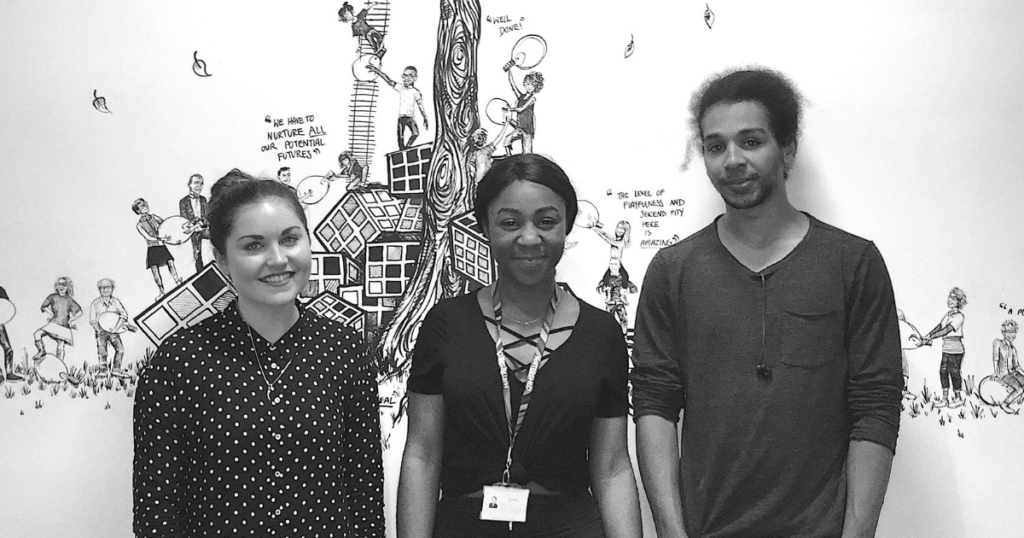“TED is a nonprofit devoted to spreading ideas, usually in the form of short, powerful talks. TED began in 1984 as a conference where Technology, Entertainment and Design converged, and today covers almost all topics”.
In this article, we have summarised for you the 10 best-known talks with the main quotes of every speaker. Discover more below…
- 1. Robert Waldinger: Good relationships keep us happier and healthier
- 2. Andrew Solomon: How the worst moments in our lives make us who we are
- 3. Carol Dweck: The power of believing that you can improve
- 4. Simon Sinek: How great leaders inspire action
- 5. Brené Brown: Listening to shame
- 6. Cameron Russel: Looks aren’t everything, look at me. I’m a model
- 7. Celeste Headlee: Talk in two minutes
- 8. Tom Thum: The orchestra in my mouth
- 9. Maz Jobrani: Can we break stereotypes?
- 10. Shawn Achor: The happy secret to better work
- Mind Map Pro at TEDxBristol 2017
1. Robert Waldinger: Good relationships keep us happier and healthier
Happiness is one of the most important things in life even if it’s the hardest to study. During Robert’s talk, he pointed out three lessons about happiness:
- Close relationships:
Being closer to family and friends tend make people happier. - Quality of relationships over quantity:
Robert took the example of married couples who argue constantly, saying that they are less happy than people who are not married at all. At 30, people tend to prefer quality relationships than quantity. - Stable, supportive marriage:
Relationships are critical for our health and in general, married people are more happy than divorced people.
“We’ve learned three big lessons about relationships. The first is that social connections are really good for us, and that loneliness kills. It turns out that people who are more socially connected to family, to friends, to community, are happier, they’re physically healthier, and they live longer than people who are less well connected.”
2. Andrew Solomon: How the worst moments in our lives make us who we are
Andrew talked about how the worst moments in our lives are not dead ends but provide a chance to reinvent ourselves. Those moments help to move us forward. He says that we need to take the traumas and make them part of what we become.
Andrew defines happiness as “nirvana”, explaining that we must be at peace with ourselves in order to find happiness in the most difficult times.
“It is what you arrive at when you have only bliss to look forward to and find in what looked like sorrows the seedlings of your joy.”
3. Carol Dweck: The power of believing that you can improve
During her talk, Carol encourages us to consider the power of the words “not yet” as a substitute of the word “failure”. Instead of “I can’t”, “I’m no good”, or “I failed”, try telling yourself the story of “not yet” which means that you’re still learning.
She considers three aspects:
- How to improve the power of believing
- Growth mindset
- How we can transform a meaning of effort and difficulty into positive energy
Carol explained that we must believe in our own abilities in order to develop a growth mindset and regard failures as part of a learning process for achieving new skills. Acting like this can improve our relationships with others and help us to be more successful.
“Praise wisely. Rather than praising their intelligence or talent, praise the process that children engage in – their effort, their strategies, their focus, their perseverance, and their improvement. This encourages more effort, more engagement over longer periods of time, and more resilience.”
4. Simon Sinek: How great leaders inspire action
During his speech, Sinek offers three main examples of successful leaders and organisations. He uses Martin Luther King as an example of a successful leader, the Wright brothers, and Apple. One of the examples of a successful organisation he uses is Apple, describing how they are so successful at what they do. He talks about these main points:
- Inspirational leadership
- He discovers pattern in how leaders think, act and communicate
- How leaders can inspire change and trust?
“About three and a half years ago, I made a discovery … As it turns out, all the great inspiring leaders and organizations in the world, whether it’s Apple or Martin Luther King or the Wright brothers, they all think, act and communicate the exact same way. And it’s the complete opposite to everyone else. All I did was codify it, and it’s probably the world’s simplest idea. I call it the golden circle.”
5. Brené Brown: Listening to shame
During her talk, Brené Brown talks about broken behaviour and what can happen when people affront their shame head-on.
She talks about how vulnerability can affect your life negatively, saying that we need to stop thinking of vulnerability as a bad thing and that it is better to see it as courage. She defines vulnerability as a viral hit.
“I learned something hard about myself, and that was that, as much as I would be frustrated about not being able to get my work out to the world, there was a part of me that was working very hard to engineer staying small, staying right under the radar. But I want to talk about what I’ve learned.”
6. Cameron Russel: Looks aren’t everything, look at me. I’m a model
Cameron talks about the fact that young girls who dream of being a model should think of it like something to shoot for, but “not a career path.” The talk goes on to explore the common tendency to think that life would be better and easier if we were more beautiful, but Cameron explains that when you meet a group of models, they are the most insecure women on the planet.
While many bemoan the use of Photoshop for making models look thinner and imperfection-free, Cameron says that this is just the tip of the iceberg. She says that the images we see of her do not reflect reality, but are careful constructions built by stylists, makeup artists and photographers.
“If you ever think, “If I had thinner thighs and shinier hair, wouldn’t I be happier,” you just need to meet a group of models. They have the thinnest thighs and the shiniest hair and the coolest clothes and they are the most physically insecure women, probably, on the planet.”
7. Celeste Headlee: Talk in two minutes
In her speech, Celeste talks about the 10 ways to have a better conversation. Good conversation is becoming a lost art: inspiration, engagement and a feeling of genuine connection can lead to a more fulfilling relationship. These are her recommendations:
- Don’t multitask: Instead, be present.
- Don’t dominate: Good conversation means both people speak.
- Ask open-ended questions: Questions such as “What was it like?” or “How did it make you feel?” provoke more insightful responses.
- Go with the flow: It’s important to not hang on to points that pop into your mind for too long.
- If you don’t know, say you don’t know: Don’t pretend to know something you don’t. Doing this devalues the knowledge you do bring the table.
- Don’t equate your story with someone else: Avoid reacting to someone’s experience by talking about a similar one of your own. It might seem the same, but it never is.
- Try not to repeat yourself
- Don’t get lost in the details: Fixating on details can slow conversation to a halt.
- Listen: This is the most important one. It is important to pay attention to someone. It is important to listen with the aim of understanding the other person.
“A good conversation is like a miniskirt – short enough to retain interest but long enough to cover the subject.”
8. Tom Thum: The orchestra in my mouth
This is not a speech but a mouthful of instrumental impersonations crammed into 11 minutes of creativity by beatboxer, Tom Thum:
9. Maz Jobrani: Can we break stereotypes?
In his talk, Iranian-American comedian and actor Maz Jobrani describes a comic’s role in challenging stereotypes — especially when it comes to Middle Eastern Muslims in America.
Maz says that hopefully in the next few years, muslims or Middle Easterners will be seen as normal people in the media. He is saying that he would like to see the media show muslims as normal human beings rather than the screaming caricatures that the media depict them to be.
“There was a white America guy in Austin, Texas, who flew his airplane into the IRS building. And I happened to be in Austin that day doing a standup comedy show, and I’ll tell you as a Middle Eastern male, when you show up around a lot of these activities, you start feeling guilty at one point … I was watching the news – I’m like, am I involved in this crap?”
10. Shawn Achor: The happy secret to better work
When studying people, we tend to look for excuses and to find a line of best fit. This is what Shawn calls the cult of the average. Instead we should look more at the positive factors which describe people: what makes them different?
Shawn says that we should study happy people and learn why they are happy, rather than think about how to make depressed people happier.
“The absence of disease is not health. Here’s how we get to health: We need to reverse the formula for happiness and success. In the last three years, I’ve traveled to 45 different countries, working with schools and companies in the midst of an economic downturn. And what I found is that most companies and schools follow a formula for success, which is this: If I work harder, I’ll be more successful. And if I’m more successful, then I’ll be happier. That undergirds most of our parenting styles, our managing styles, the way that we motivate our behavior.”
Mind Map Pro at TEDxBristol 2017
To amplify the powerful ideas that are explored through TEDxBristol, Mind Map Pro is supporting the event in two ways:
- Live mind mapping talks so that knowledge, thoughts and personal stories from the speakers are available to online visitors in real-time.
- Providing free tickets for people from diverse groups in the local communities to attend the event through the Community Partnership Programme.
Follow the live mind mapping at https://tedxbristol.mindmappro.com on 2-3 November 2017.



